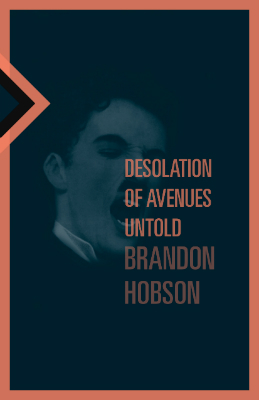
There is a remote corner of contemporary literature where top-notch literary fiction is being held down by powerful voices and getting injected with beautifully outré storytelling and elements so strange that they wouldn’t be out of place in a bizarro fiction novel. Brandon Hobson’s Desolation of Avenues Untold is one of the best novels to come out of that outrageous corner of the literary landscape. A narrative that confidently walks the line between a mystery with heavy doses of noir and a surrealist fantasy that also serves as an academic ode to film studies, this is the kind of novel that slaps the psyche around and delivers equal measures of confusion and pleasure.
The plot of Desolation of Avenues Untold is deceptively simple: a private collection of films involving actor Charlie Chaplin has been uncovered. The media frenzy is immediate and speculation reigns supreme. To make matters more interesting, the collection of personal films is rumored to contain at least one reel with more than 30 minutes of footage of one the great actor’s sexual encounters. The only problem is that no one really knows where the films are. Some think ex-junkie rock star Caspar Fixx had them and gave them away to a dirty politician by the name of Tim Bowery while others think one of Chaplin’s relatives is now in possession of the cinematic treasure. The man they suspect, Bornfeldt Chaplin, is a divorced nobody living in the middle of nowhere and trying hard to please his son. Between the individuals looking for the films and the lives of those suspected to have them, what follows is a bizarre, paranoid, enigmatic, and unexpectedly comedic trip through the people and streets of a fictional city that somehow manages to reflect our own reality.
There are many words that would accurately describe Desolation of Avenues Untold, but the two that are relatively uncommon in book reviews are brave and unexpected. Hobson’s prose is an elegant, dynamic animal that frantically runs in and out of literary fiction and leaves bewildering fragments behind it. For example, once the plot has been established and a few characters introduced, the author shines a light on the films a group of DIY cinema aficionados have shared to a website that caters to viewers like them. The long laundry list of films offers a glimpse into the deranged mind of the characters and help place readers in the uncanny microcosm that is Desolate City, Texas:
Big Boy, 8-minutes, Mishityu. A slow-motion film of a German Shepherd vomiting a stomach material resembling gastric blood.
Larry, 24 minutes, 35 mm, Payne. A devout Mennonite comes to terms with being sexually aroused by a man dressed as Ludwig van Beethoven.
The Woman in the Attic, 11 minutes, Bryant. A mentally challenged woman with a paralyzing fear of birds is locked in an attic with two live sparrows that fly frantically around her.
The Suburbs, 43 minutes, Klitz. In a collective attempt to understand their son’s cross-dressing, a couple discovers their own sexual fetish involving human feces.
While many literary fiction authors are afraid to grab genre fiction tools to use in their storytelling, Hobson seems to shine even brighter whenever he does exactly that. From noir to bizarro, he confidently utilizes everything available to him to craft a story that defies categorization. In fact, I think David James Keaton’s The Last Projector and this novel deserve to be taken together as the start of a very smart, very weird subgenre that mixes a love of crazy fiction and celluloid with bold, stylish prose.
Desolation of Avenues Untold revolves around films that may or may not exist, and that helps Hobson keep the tension going. However, what truly makes readers keep turning pages compulsively is the author’s knack for micronarratives, which he constantly injects into the overarching storyline. The result is a book in which each minor player has a story and every conversation can bring a plethora of tales, confessions, and fascinating discoveries. Here’s a paragraph from a conversation about the possibility of someone having been drugged by accident:
“I knew a guy who had an unhealthy sexual attachment to objects,” Pigmel said. “Something about the way the objects feel against the skin. Lamps, chairs, ceiling fans, fence posts. They were gender neutral. Nameless, faceless, gender neutral objects he loved and kissed and caressed. He was a professor of some sort who published articles in prestigious German journals and had teaching fellowships in Bern and Zurich. He was struck with frequent attacks of vomiting and diarrhea at the end of his life. He died alone. Aneurysm in the abdominal aorta. A real tragedy. His name was supposedly Kip.”
While some of what has been stated above may seem to indicate a disjointed or incoherent novel, the opposite is true. Desolation of Avenues Untold is a satisfying read that’s at both wild and coherent, which turns into an even more impressive feat when you consider that it’s over 300 pages long and that somehow flawlessly weaves the main narratives with things like abduction by dwarves and a building suffering from an armadillo infestation akin to that of some New York building suffer with rats or cockroaches.
Brandon Hobson writes novels that are very bright and incredibly dark, surprisingly funny and wonderfully complex. Desolation of Avenues Untold is the kind of narrative that can poke fun at academia while also surreptitiously celebrating all film-related obsessions, and that often happens in the same page. Civil Coping Mechanisms is one of the best indie presses out there because they constantly publish work that has nothing to do with whatever they’ve previously published, and this book is one of the strangest, most multilayered entries into their impressive catalog.
***
Desolation of Avenues Untold
by Brandon Hobson
Civil Coping Mechanisms; 306 p.
Follow Vol. 1 Brooklyn on Twitter, Facebook, Google +, our Tumblr, and sign up for our mailing list.
